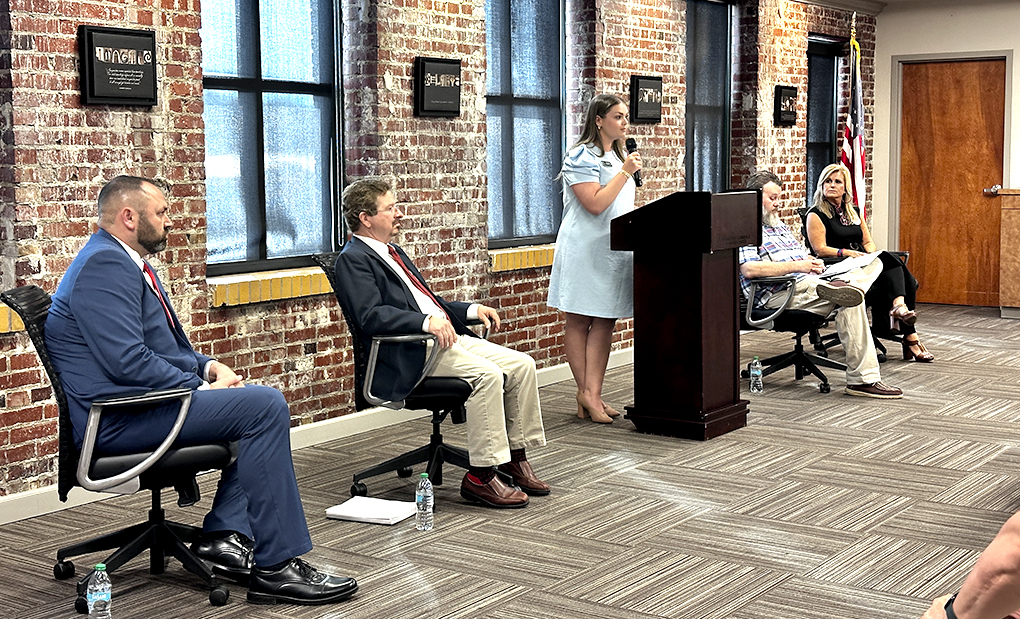Mississippi’s infrastructure funds target transportation projects, cleanup of hazardous site
Published 3:10 pm Thursday, October 19, 2023

- Passengers board a train bound for New Orleans at Union Station in Meridian in this 2018 photo. Transportation projects will get a big boost in Mississippi and across the country with the 2021 Infrastructure Investment and Jobs Act.
Infrastructure in Mississippi has been rated as poor or at risk for more than a decade, according to several surveys — most notably the American Society of Civil Engineers infrastructure report card, which is published every four years.
With the enactment of the federal $1.2 trillion Infrastructure Investment and Jobs Act in late 2021, Mississippi is expected to receive an estimated $4.4 billion over five years to aid needed improvements.
Mississippi Department of Transportation Executive Director Brad White said the act, also known as the Bipartisan Infrastructure law, has allowed MDOT to receive nearly $1 billion more than it received in the previous five-year reauthorization of the Federal Highway Administration.
The funding, he said, has allowed the state to restart its large-scale capacity program for old, large construction projects that have been in limbo for years.
“The reason that was important to us is before, we had gotten to a point where Mississippi was basically a backup state where all the money that was being generated to the fuel tax primarily was having to be spent maintaining the investment we already had, our existing system,” White said. “And so we were not able to focus on those projects that were needed in order to enhance the system.”
Through early September, $3.7 billion in infrastructure funding had been announced and is headed to Mississippi with more than 268 specific projects identified for funding. To date, $1.5 billion has been announced in Mississippi for roads, bridges, roadway safety and major projects.
The first big project is expected to begin preconstruction in November and consists of adding lanes to U.S. Highway 49, a busy thoroughfare on the Mississippi Gulf Coast, White said.
The funding is helping with preconstruction phases of several other notable transportation projects including a Port Gipson bypass and the widening of I-55 and highways 51 and 27.
As many regional thoroughfares go through Mississippi, a project to expand the I-10 freight corridor in the Diamondhead area in the gulf will receive $60 million in infrastructure dollars.
Public transportation grants
Among notable transportation investments, Mississippi is expected to receive approximately $218 million over five years to improve public transit across the state.
The National Railroad Passenger Corporation, or Amtrak, has received $178.4 million for the Gulf Coast Corridor Improvement Project through the Consolidated Rail Infrastructure and Safety Improvements Program.
The project, which is a joint effort between Amtrak and the Southern Rail Commission, will restore passenger rail service along the Gulf Coast after it was lost following Hurricane Katrina in 2005. According to a U.S. Department of Transportation summary, the project will help facilitate the introduction of intercity passenger rail service to two round-trip trains per day and help achieve targeted trip times and service reliability for freight operations.
According to Amit Bose, administrator for the Federal Railroad Administration, such funding will build safer, more resilient railroads throughout the country.
“We’re going to improve nearly 1,900 miles of track, rehabilitate or replace more bridges, enhance highway rail grade crossings, build and rebuild sustainable infrastructure that protects against the threats of extreme weather and a changing climate,” he said at an event Oct. 7 in Meridian.
EPA funding
About $21 million will go to the Environmental Protection Agency to clean up the site once known as Mississippi Phosphates, a former diammonium phosphate fertilizer operation.
When Mississippi Phosphates went bankrupt in 2014, the EPA was left to remediate the site, which was left with contaminated grounds that could cause contaminated groundwater in the area.
According to Craig Zeller, remedial project manager in the EPA Region 4 Superfund Division, much of the infrastructure funds for the site have been used toward treating acidic water and landfill closure for the chemical stacks onsite.
The site was the cause of at least two known widespread devastating impacts on the ecosystem due to hazardous chemicals.
“What we had was about 350 acres of acid generating material,” Zeller said. “So when one inch of rain would hit this acid generating material, it’s waste material and becomes contact water that’s high in nutrients and low in pH that we have to trap and treat to prevent an uncontrolled release of untreated water to the bayou.”
Zeller estimates a total of $200 million in federal funds will have been expended on the effort, with cleanup to be complete by 2027.
“It’s been a very expensive environmental legacy to clean up,” he said. “It’s a very unique site (in) EPA’s portfolio.”
Prior to the Bipartisan Infrastructure Law and the Inflation Reduction Act, Zeller said there were at least 49 sites nationwide awaiting cleanup from a remedial decision that had been issued; however, no dollars were available to procure contracts.
“When BIL hit a couple years ago now, it was a huge game-changer. All 49 sites got funded overnight,” he said. “We’re cleaning up sites and communities and returning sites that were once impacted and contaminated and get them cleaned up and returned them to beneficial reuse. We’re putting a lot of people to work … buying a lot of diesel fuel … the economic benefit goes beyond the cleanup itself.”
To date, approximately $26.8 million has been allocated to Mississippi in 2022 and 2023 for capping orphaned oil and gas wells and reclaiming abandoned mine lands, and $39.5 million has been allocated to cleaning up brownfield sites.
A total of $3.5 billion is being invested nationally to clean up priority hazardous waste sites.
Other plans
According to a White House update, other notable initiatives in Mississippi funded through the infrastructure law include:
• $1.2 billion through the Broadband Equity, Access and Deployment Program to provide access to high-speed internet to everyone in Mississippi. Approximately 231,000 households in Mississippi are enrolled in the Affordable Connectivity Program.
• $160 million to provide clean and safe water across the state through the EPA. Of that, $59.2 million is dedicated to lead pipe and service line replacement, with another $45.7 million for safe drinking water investments that can also support lead pipe replacement.
• $36.4 million so far to Mississippi schools through the EPA’s Clean School Bus Program. Communities in Mississippi have been awarded $16.9 million for clean transit buses and improved bus service through Department of Transportation’s Low- and No- Emission Bus and Bus and Bus Facilities Program.
• Roughly $51 million in formula funding over five years through the National Electric Vehicle Infrastructure Program to support the expansion of electric vehicle charging in the state.
• $58.9 million for clean energy, energy efficiency and power, to include $12.6 million to prevent outages and make the power grid more resilient.
• Approximately $57.6 million in 2022 and 2023 for airports.
• Roughly $49.4 million for ports and waterways.
• Approximately $451.7 million for infrastructure resilience, including $225.2 million through the Army Corps of Engineers for flood mitigation.
The Infrastructure Investment and Jobs Act passed the U.S. Senate by a bipartisan vote of 69-30 in August 2021, followed in November of that year with passage in the U.S. House on a vote of 228-206.
Mississippi’s congressional delegation voted along party lines, with the exception of Republican U.S. Sen. Roger Wicker, who voted in favor of it.





